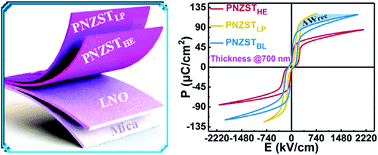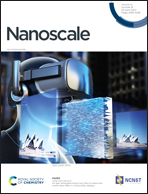Enhanced energy-storage performance of an all-inorganic flexible bilayer-like antiferroelectric thin film via using electric field engineering
Abstract
A novel all-inorganic flexible bilayer-like Pb0.99Nb0.02(Zr0.55Sn0.40Ti0.05)0.98O3 (PNZSTBL) thin film with the same chemical composition is designed to enhance its energy-storage performance. The PNZSTBL thin film that consists of a large polarization (PNZSTLP) top layer and a high electric breakdown field (PNZSTHE) bottom layer are deposited on flexible mica by controlling the sputtering pressure. The dislocations in such a bilayer-like film can be repressed effectively owing to the identical chemical composition. Most importantly, the PNZSTBL exhibits the complementary advantages of the PNZSTHE and PNZSTLP films based on the electric field amplifying effect and interlayer coupling. An enhanced recoverable energy-storage density (Wrec) of 39.35 J cm−3 is achieved in the PNZSTBL thin film, which is 70% higher than that of the single-layer PNZSTLP. Meanwhile, the flexible PNZSTBL thin film enjoys an outstanding stability in terms of frequency (10–5000 Hz) and temperature (30–170 °C). In addition, the flexible PNZSTBL thin film shows a favorable mechanical cycling endurance after repeated bending 1200 times for a 3.5 mm tensile radius. This work offers a fresh strategy to design prospective bilayer-like dielectric thin films for optimizing the energy-storage performances of materials.



 Please wait while we load your content...
Please wait while we load your content...